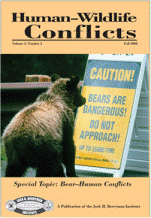Center, Internet, Wildlife Damage Management

Human–Wildlife Interactions
Date of this Version
Fall 2009
Document Type
Article
Abstract
The National Wildlife Strike Database for Civil Aviation in the United States became operational in 1995 with the initiation of data entry of all strike reports beginning in 1990. The database contained 82,057 reported strikes from 1990 to 2007. About 9,800 of these strike reports noted damage to the aircraft, of which 2,700 indicated the damage was substantial. The database has proven to be a useful source of objective information on the extent and nature of wildlife strikes for personnel at individual airports and for researchers and regulatory agencies at the national level. With the impending requirement for airports in the United States to manage safety risks through a formal safety management system (SMS) approach, we propose that the database can be a key element for prioritizing wildlife risks and providing objective benchmarks of the effectiveness of wildlife hazard management plans (WHMP). We propose that airports use the number of damaging strikes ranked by causative species over the most recent 5-year interval in combination with species-specific wildlife count data prioritized by likelihood of damage. This would guide species-specific management actions to minimize future risk. We further propose that a benchmark or threshold rate of 0.96 damaging strikes per 100,000 aircraft movements per year be established. Any airport exceeding this damaging strike rate in a given year should reevaluate its WHMP, with a focus on those species posing the greatest risk. To enhance the utility of the database in an SMS, improvements are needed in the level and quality of reporting. In particular, all strikes and the wildlife species involved in them should be reported. During the past 13 years, the National Wildlife Strike Database has provided a scientific foundation for the various efforts underway to reduce the problem of wildlife strikes with aircraft. Improvements in reporting, as outlined above, will make the database even more useful as part of an SMS to enhance safety at airports nationwide.


Comments
Published in Human–Wildlife Conflicts 3(2):167–178, Fall 2009. Published and copyright (where applicable) by Jack H. Berryman Institute http://www.berrymaninstitute.org/journal/index.html